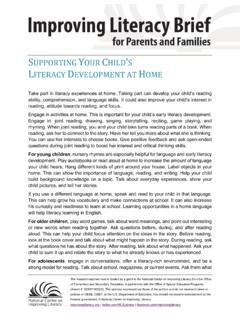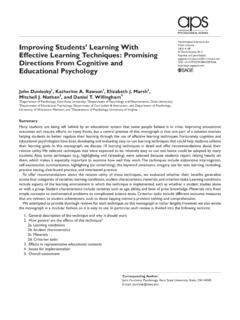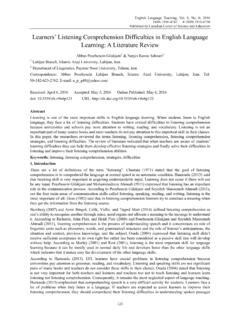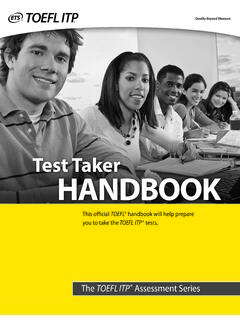Transcription of Screening for Dyslexia - National Center on Improving Literacy
1 Screening FOR Dyslexia | | 1 This report was authored and prepared by the members of the National Center on Improving Literacy including: Yaacov Petscher, ; Hank Fien, ; Christopher Stanley, ; and Brian Gearin. Authorship is also attributed to Nadine Gaab, at Boston Children s Hospital/Harvard Medical Center , Jack M. Fletcher, at the University of Houston, and Evelyn Johnson, at Boise State University. We also acknowledge Drs. Donald L. Compton and Christopher W. Schatschneider at Florida State University for initial feedback in the development of this work. RECOMMENDED CITATION: Petscher, Y., Fien, H., Stanley, C., Gearin, B., Gaab, N., Fletcher, , & Johnson, E. (2019). Screening for Dyslexia . Washington, DC: Department of Education, Office of Elementary and Secondary Education, Office of Special Education Programs, National Center on Improving Literacy .
2 Retrieved from The research reported here is funded by a grant to the National Center on Improving Literacy from the Office of Elementary and Secondary Education, in partnership with the Office of Special Education Programs (Award #: S283D160003). The opinions expressed are those of the authors and do not represent views or policies of OESE, OSEP, or the Department of Education. You should not assume endorsement by the Federal government. National Center on Improving Literacy . | | 2 Screening FOR Dyslexia Policy, Emerging Research, and Best Practices In recent years, there has been a sharp increase in the number of states seeking to reform education for students with Dyslexia . Although states vary in their approaches to reform, state legislation has tended to promote (1) a common definition of Dyslexia , (2) universal Screening during elementary school, (3) academic, preventative intervention in the early grades, (4) the use of evidence-based interventions, (5) the use of explicit and/or structured sequences of instruction, (6) professional development to facilitate these objectives, and (7) appointing advisory boards to assist with the implementation challenges at the district level (Gearin, Turtura, Kame enui, Nelson, & Fien, 2018; see also Youman & Mather, 2013, 2015, 2018).
3 Each of these legislative considerations has potential to add to existing challenges and opportunities or to create new ones for school systems. Universal Screening for Dyslexia risk is one of the most promising, but most challenging elements of the Dyslexia education reform effort. Although the Individual with Disabilities Education Act (IDEA, 2004), includes Dyslexia as a part of the specific learning disability definition and while there is some degree of definitional agreement, there is still variation in how states implement IDEA when providing Screening specifically for Dyslexia . At the time of this writing, twenty-one states have opted legislation inclusive of universal Screening systems for risk for Dyslexia ( National Center on Improving Literacy , 2018). Many other states are considering such. Previous initiatives, particularly Reading First, emphasized universal Screening and shared other objectives with the newer Dyslexia initiatives.
4 The term Screening refers to the brief evaluation of a defined population of individuals to identify the risk for performing below a specified threshold or benchmark on a specified outcome (Morabia, 2004). Screenings in the medical community are commonplace, such as the routine evaluation of blood pressure being measured as a screen for hypertension or blood being drawn to screen for diabetes or risk for heart disease via levels of cholesterol. In these examples, Screening for health disorders requires a balance of benefits and risks. The main benefit of Screening for health risk is that individuals who present with a positive | | 3 test result, such as high blood pressure, can be provided with early treatment such as recommended lifestyle changes that may reduce the risk for heart disease. A positive Screening for a disorder or its risk may also lead to additional evaluation before interventions are provided, such as the use of medications to reduce risk for heart disease ( , anti-hypertensives or cholesterol reducing drugs).
5 It is important to consider other contextual factors associated with Screening such as the accuracy and utility of Screening devices, financial costs ( , for buying Screening materials or training personnel), increased anxiety for the tested individual, the provision of unnecessary treatments to those who are incorrectly screened as at risk for a disorder, or the failure to provide necessary treatment to individuals who are incorrectly screened as not at risk for a disorder. The purpose of universal Screening for Dyslexia risk is very different than the purpose of diagnosing Dyslexia . Screening determines the level of risk for reading problems in general and the potential risk of having or developing Dyslexia . It is not appropriate to use Screening results to formally diagnose whether an individual actually has Dyslexia . Accordingly, universal Screening for Dyslexia risk follows a qualitatively different process than the process used for diagnosing Dyslexia .
6 Screening procedures for Dyslexia risk should be efficient and inexpensive and should be used for all students in a classroom. In contrast, diagnosis or identification of Dyslexia requires a more comprehensive, time consuming, and expensive evaluation procedures and should only be applied to individuals in the population that have demonstrated elevated levels of risk demonstrated by Screening results, have not responded adequately for generally effective early reading intervention, or both. Valid Screening methods should go hand in hand with valid identification and diagnostic methods. The chief benefit of universal Screening for Dyslexia risk is that it could prevent the reading problems associated with early common, but often under-identified reading disability. Reading intervention in early elementary school clearly reduces the risk for a reading problem in general, and specifically word-level reading problems epitomized by Dyslexia .
7 It is of paramount importance that states, districts, and schools take action to improve services for students with Dyslexia , which begins with efforts at early Screening and preventative intervention. | | 4 Although universal Screening for Dyslexia risk could potentially help many students struggling with reading, it also poses risks and challenges for school systems and the students within them. Implementing an effective universal Screening system to understand students risk for reading disabilities, including Dyslexia , is not a simple matter of selecting and administering a one-time test to select children. Rather, all students in all grades should be screened multiple times a year. The most important issue is the reliability and validity of decisions made by professionals and families based on the Screening method. Developing an effective Screening system for Dyslexia requires an inherent trade-off between correct and incorrect classifications from the screener, and more importantly, the risks associated with two types of incorrect Screening results; one where the screener says the student is at risk but doesn t perform below a specified threshold or benchmark on a specified outcome (false positive error) and one where the screener says the student is not at risk but ends up performing below a specified threshold or benchmark on a specified outcome (false negative error).
8 The issue with false positives is resource driven. If the screener generates too many false positive errors, it can drain and potentially become a waste of resources to provide intervention and/or additional assessment to students who did not need the extra support. However, the consequences of a false negative error, which could mean lack of access to early reading intervention, is perhaps more serious because of the need for students with or at risk for Dyslexia to receive explicit reading instruction as early as possible in the period where reading acquisition is prioritized (kindergarten Grade 2). Accounting for the reliability and validity of scores from screener assessments, with special attention to the types of errors that are made in Screening systems is critical. Scores from a given screener may be unreliable because of its poor psychometric properties or lack validity due to the methods not being sensitive to the risk characteristics associated with Dyslexia .
9 In these cases, the resultant decisions about students may be uninformative or misinformative. Alternatively, a screener may have good psychometric properties, but be used by educators or families in ways that are not supported by research or the purposes of the screener. For example, a valid screener for determining a student s risk associated with developing social skills may not be valid for determining if a child is at risk for a reading disability or Dyslexia . | | 5 DESCRIPTION OF OUR PAPER SECTIONS Given the importance of the early identification of Dyslexia , the present paper aims to provide an overview and some insight into what is known about Screening for Dyslexia risk. Section I provides a brief overview of what is Dyslexia and the importance of Screening for Dyslexia risk. In Section II of this paper, we discuss the neurological and behavioral aspects relevant to Dyslexia as well as the emerging research in both areas.
10 Section III provides a robust presentation of viewpoints and considerations for best practices in behavioral Screening . Section IV provides a brief overview of key statistical considerations one should consider when evaluating a screener with a companion technical report provided in Appendix A. Section V concludes with a checklist to support teachers, school psychologists, and school-based assessment teams in evaluating and choosing universal screeners. | | 6 SECTION I WHAT IS Dyslexia ? Dyslexia is the most common learning disability, historically reported as affecting 5-17% of children (Cortiella & Horowitz, 2014; Shaywitz, 1998). It is commonly understood as a brain-based specific learning disability that impairs a person's ability to spell words in isolation accurately or to read single words fluently (Peterson & Pennington, 2015). It cannot be explained by poor vision or hearing or lack of motivation or educational opportunities.





